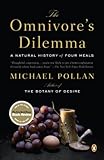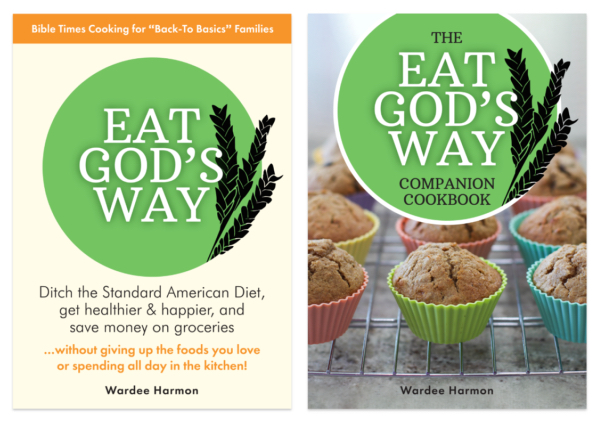Every Monday, I pull out a meaningful quote from one of the great books or articles I’m reading (or re-reading) and share it with you.
Last week, we talked about whether or not a small amount of grain-finishing is appropriate for grass-fed pastured herbivores such as cattle and sheep. Sally Fallon Morell, in Nourishing Traditions, says that since they’ll eat some seeds and grains in the wild, a small amount of grain finishing is traditional. Many commenters thought grain-finished beef tasted better than 100% grass-fed, while another suggested that a cow who is finished on any grain experiences a souring of the stomach and a drop in nutrition of the finished meat. I am open to continuing that discussion, but the quote I’ll share today is from the other side.

I mean, really, the other side. The cow’s side.
Michael Pollan, in The Omnivore’s Dilemma, takes us into the mind of a cow who is being led onto fresh pasture. (Not just any pasture, though. This is Joel Salatin’s “salad bar” pasture.)
“When one of his [Salatin’s] cows moves into a new paddock, she doesn’t just see the color green; she doesn’t even see grass. She sees, out of the corner of her eye, this nice tuft of white clover, the emerald-green one over there with the heart-shaped leaves, or, up ahead, that grassy spray of bluish fescue tightly cinched at ground level. These two entities are as different in her mind as vanilla ice cream is from cauliflower, two dishes you would never conflate just because they both happen to be white. The cow opens her meaty wet lips, curls her sandpaper tongue around the bunched clover like a fat rope, and with the pleasing sound of tearing foliage, rips the mouthful of tender leaves from its crown. She’ll get to the fescue eventually, and the orchard grass, and even to quite a a few of the weeds, but not before she’s eaten all the clover ice cream she can find.”
This sounds like a very happy cow – and one who know just what she wants to eat. Correct me if I’m wrong, but in this style of management intensive grazing, no cow will be in a paddock when it is at the seeded state. These cows never do munch on wild grains or seeds, which according to Salatin, are less palatable anyway due to the woodiness of the grasses. Their diet is delectable, moist green shoots of many types. And after two happy seasons of feasting on rapidly growing green grass (and an overwintering with high quality hay), animals raised this way are primely nutritious and ready for us to enjoy (with thanksgiving).
So… what do think of the other side?
Note: The book link in this post is an affiliate link to Amazon.com. If you choose to buy the book via my link, I’ll earn a commission. But I don’t care about that too much. The point of this post is for us to share inspirational words. That’s my sincere disclaimer. Thanks for reading.
...without giving up the foods you love or spending all day in the kitchen!

2 free books:
Eat God's Way
Ditch the Standard American Diet, get healthier & happier, and save money on groceries...
We only recommend products and services we wholeheartedly endorse. This post may contain special links through which we earn a small commission if you make a purchase (though your price is the same).


At first I was confused and then I realized you mustve meant GRAIN-finished at the beginning (emphasized in green). Or am I really just confused?!
You’re right! I wrote the wrong word – fixed now. Thanks for catching it! 🙂
It’s funny, I am in the middle of reading this book. It makes me want to read everything Salatin wrote; after reading the first section, I was just depressed (I have read so many books on CAFO and factory farming), but the Salatin section was kind of like “OK, now what can we do to fix the problem.”
I have to say, I am thinking that Salatin’s system does seem like the optimal system. Cows are meant to eat grass. Sure, there might be a few seeds here and there, and maybe some crabgrass, but that really is the ideal. I think if you have to have grain-finished beef because it’s the only choice, it’s still better than grain-fed beef.
.-= Rebecca´s last blog post… Menu Plan Monday – Week of 11/09/09 =-.
I have not read any of this author’s work, but he describes an open pasture raised cow’s eating habit very well. Our cows definitely search out the ice cream first (clover) before munching on regular grass. When weeds or anything else growing in the pasture is at the seeded state they completely ignore it.
I’m good with grain finished meat as long as the grain fed is organic or as very least GMO. Most times the farmer will state that they don’t use pesticides on there pastures and sometimes will state what kind of grain. Hate for the cows to be raised “right” only to be fattened on grain treated with pesticides. It would kinda blow the whole thing up for me.
Nikki
Oh, and as far as your quote…..I read it and really would like to roll in a patch of clover, then sit and nibble a little myself. What a great cow visual! It was great quote.
Nikki
Great quote. I just finished reading The Omnivore’s Dilemma and really enjoyed it. Pollan has such an easy and accessible style, making what can be quite a ‘heavy’ subject an enjoyable read.
I love his descriptions of his time at Salatin’s farm, it is so interesting to hear about how everything is tied to everything else, it gave me many ideas and things to think about for our little homestead.
.-= Heidi´s last blog post… Pondering parsnips =-.
Wardee, you have become the first place I turn when looking into new techniques for healthy living… and I find myself a little overwhelmed now that I have ordered a side of beef. I usually buy individual frozen cuts from the guy where I get my raw milk (he’s in a co-op with cattle, goat and chicken farmers, and actually raises/sells buffalo himself), but as our “rapidly growing grasses” season is nearing its close, I felt this was a prime time to buy a grass-fed cow. And, this was the closest post I could find that might relate!
Does anyone have any suggestions as to what cuts to request when the processor calls me? The farmer may have inadvertently caused me a little anxiety on this note by grilling me with questions as to what cuts I would want, etc. Either way, I am a bit nervous waiting for the call to come in from the plant. My folks bought 4-H cows when I was a kid, but this is my first experience! Any suggestions? Things to avoid? I am already planning on telling them I want everything they’ll give me, including bones, tongue, organs, etc. (farmer actually poked fun at me that I can’t have half of the tongue. Um… duh?)
THANKS!
Dani — I hope someone can help you. I’m not really an expert at this. But I can tell you what we do. I should preface it by saying that we’re not steak lovers. So we only keep the choicest steaks (T-bone, tenderloin) and the choicest roasts (rump and tri-tip) and I get the so-so steaks cut up into stew meat (sirloin) and everything else gets ground. You could also ask the processor for advice on the tenderest cuts. Keep the fat, too, for tallow!
AH! Thanks for the reminder on the fat! I have tallow coming out my ears still–I bought a 5-gallon bucket on sale at US Wellness meats over 6 months ago, and we’re maybe 1/4 of the way through it! Looks like I need to get some lye and make some soap! Still, though; I can always use more… um, that is, if my freezer is big enough!